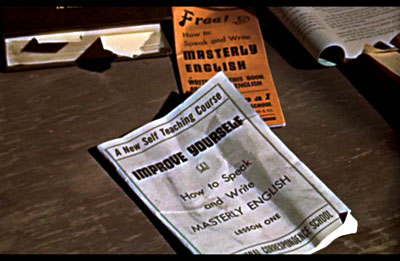 BUY IT AT AMAZON: CLICK HERE!
BUY IT AT AMAZON: CLICK HERE!
STUDIO: Warner Bros.
MSRP: $68.92 RATED: NR
RUNNING TIME: 430 Minutes
SPECIAL FEATURES:
• Documentaries
• Rare Screen Tests
• Wardrobe Tests
• Additional Scenes
• Premiere Footage
• Photo Galleries
• Giant – English Dolby Surround Stereo
Note to Nick and Readers: I apologize for not getting this review posted sooner. A new house has taken up most of my life as of late. That’s my excuse.
Whether you like it or not, James Dean is a cultural icon.
I’ve always gotten this young Marlon Brando vibe from James Dean. I feel this now more than ever, particularly when watching scenes where Dean goes from being quiet to abruptly exploding with emotion. These three films and verbal recollections from people who knew him are the only things we have left of Dean, so one can’t predict what would have become of his career. Yet, considering his spontaneous acting and his dedicated work ethic, I like to believe that he would have built up quite an impressive resume for all of us to enjoy.
Each film in the James Dean Collection is presented on two discs, each sporting “special edition” qualities within. Let’s start off with…
East of Eden (1955)
 Cal (James Dean) loves his father Adam (Raymond Massey). The only problem is that Cal’s father loves his other son, Aron (Richard Davalos), more. A lot more, actually. Whatever Cal does just doesn’t seem to be up to his father’s standards. This leaves Cal in a constant state of confusion, a state in which leaves him pondering how he will gain the love and affection of his hard-nosed father. A key to Cal’s better understanding of his efforts to gain his fathers love comes in the form of Abra (Julie Harris), Aron’s soon-to-be wife and a close friend of Cal’s.
Cal (James Dean) loves his father Adam (Raymond Massey). The only problem is that Cal’s father loves his other son, Aron (Richard Davalos), more. A lot more, actually. Whatever Cal does just doesn’t seem to be up to his father’s standards. This leaves Cal in a constant state of confusion, a state in which leaves him pondering how he will gain the love and affection of his hard-nosed father. A key to Cal’s better understanding of his efforts to gain his fathers love comes in the form of Abra (Julie Harris), Aron’s soon-to-be wife and a close friend of Cal’s.
Cal has to face his father after throwing a furious temper tantrum and destroying a group of ice blocks by tossing them down a slide from inside a factory that Cal’s father is considering to purchase for his lettuce company. Cal’s father scorns his son for his actions and forces him to read verses from a Bible, verses he feel will help his son get on better path to life. Even though Cal aims to gain his father’s love, he refuses to go along with his disipline.
After discovering that the chilled cars full of his lettuce on a train have gone bad, Cal’s father is left penniless. Seeing the pain and disappointment of his fathers plan gone bad, Cal sets out to get his fathers money back and to earn the love he feels his father should have for him. Cal invests in beans, but not before asking his estranged mother, Kate (Jo Van Fleet), for the starting money. After some consideration, Kate gives Cal the money and Cal quickly profits due to a jump in price once the war (World War I) begins.
As a side note, I feel in order for this film to work better, there needs to be a lot more focus on the sibling rivalry in replacement of the massive amount of time Cal spends moping throughout the film. From the beginning we can tell that Cal’s character is on a set course for destruction unless he gains the love for his father. I’ve never read the novel, so I’m not sure if there is more emphasis on the brothers in that medium.
Eventually ending events come at a furious pace once Cal reveals to his brother that their mother is still alive. This makes the ending feel very rushed, most likely due to condensing the novel into movie form. This reduces the film from the epic nature that I was expecting.
James Dean demonstrates a good acting performance here, possibly better if not for the stunted character arc he is forced to portray. There’s room for improvement here, yet the subtle nuances Dean gives to Cal force us to care more about him even when the film ends with a giant whimper.
7.2 out of 10
First is a new 50th-Anniversary documentary titled East of Eden: Art in Search of Life. The documentary spends much of its beginning discussing the relationship between Kazan (the director) and Steinbeck (the writer). There are a number of interview segments and stories told from the cast, crew, and family member’s perspectives to fill in the rest of the running time.
A vintage documentary Forever James Dean does a pretty decent job depicting Dean’s childhood and how he looked into that experience when playing Cal in front of the cameras for East of Eden.
Also included are a number of “deleted scenes” which are pretty much alternate versions of scenes that were used as screen tests. Plenty of time is dedicated to silent wardrobe, costume, and production design tests which I will admit I watched on fast forward. The track lasts over a good 15 minutes and I discovered the intense boredom these camera tests provide about five minutes in.
Finally, there’s footage from the 1955 New York Premiere of the film in addition to the theatrical trailer.
7.5 out of 10
The Artwork
I’m not a huge fan of this particular piece of artwork, but it works for this particular occasion. The painted retro look definitely helps out.
8.5 out of 10

Rebel Without a Cause (1955)
 Jim Stark (James Dean) is a troubled kid. Yet it’s all based on being a misguided teenager. Jim’s mother (Ann Doran) is overprotective and his father (Jim Backus, of Mr. Magoo and Gilligan’s Island fame) is a coward when it comes to connecting emotionally with his son.
Jim Stark (James Dean) is a troubled kid. Yet it’s all based on being a misguided teenager. Jim’s mother (Ann Doran) is overprotective and his father (Jim Backus, of Mr. Magoo and Gilligan’s Island fame) is a coward when it comes to connecting emotionally with his son.
With this, Jim tends to be a loner and the film opens with him lying down on the sidewalk in a drunken stupor next to a toy monkey. Jim cares for the monkey by covering him up with a piece of newspaper, as if he is tucking him into bed. (This is a good example of Dean’s creative acting spirit, as his impromptu acting tends to shine through many of his scenes throughout the film.) From here Jim is whisked away to the police station where he is questioned by Officer Fremick (Edward Platt). We spend a good amount of time at the police station where we are introduced to two of our other main characters; a young girl named Judy (Natalie Wood) and a disturbed young man named John ‘Plato’ (Sal Mineo).
Judy is your run of the mill teenage girl from the 1950’s. At least she is according to Hollywood standards from the time. There’s something explosive building up inside Judy but we just can’t quite put our finger on it just yet. Plato, on the other hand, comes off as a very quiet and disturbed young man. During the sequence inside the police station, you can actually overhear an officer asking Plato why he “shot the puppies”. These early introductions in the police station give us a good indicator of who these kids are. Or do they?
As the film moves forward, we discover more in regards to Jim’s misguided nature; Jim’s father won’t give him a straight answer on how to handle teenage life, fearing that something terrible will happen to him. Jim’s love for his father shows through in these scenes and it’s obvious to me that Jim would probably stay out of a majority of the trouble he gets himself into if his father would simply lead him in the right direction and tell him to do the right things. But its trouble that once again catches up with Jim and his parents decide that they will flee town once more. This pushes Jim over the edge and he leaves their home in a furious manner. This explosive father/son dynamic is what fuels the plot, yet it’s these short scenes that don’t seem take importance over other grander scenes throughout the film.
In my eyes, Judy is the weakest and most underwritten character of main trio. I mean, Christ, her boyfriend dies and she immediately latches onto the guy that played a part in that? Nevertheless, with some reflection on my part it all makes sense. (The teenage mind is a beautiful thing, isn’t it?) Like Jim, Judy has problems of her own at home. Her father no longer feels that she should be clinging all over him, that she’s “too old for things like that”. This problem for Judy seems like the end of the world to her, but in reality her problem is minor compared to the range of emotions she will go through before the film draws to its conclusion. For me, Judy’s strongest moment in the film is after Buzz takes the leap in the car and everyone is at the edge of the cliff looking down. Everyone evacuates, except for Judy. She stands there in desperation and leaping after Buzz doesn’t seem out of the question. Jim sees this and slowly reaches out to her. Judy does the same and Jim pulls her back from the edge. For me, it’s the strongest scene in the film. Its quiet nature allows it to go unseen, but there’s a ton of emotion flowing through the scene and validates Jim and Judy coming together in the third act of the film. Without this scene I don’t think I could believe the bond between Jim and Judy being as close as the director shows us by the end of the film.
As the police arrive, Plato flees from the members of Buzz’s gang and ends up shooting one of them in the process. The police chase Plato down and end up forcing him to flee inside the nearby observatory. Jim and Judy manage to sneak inside the observatory with the intentions to lure Plato out safely. Tensions rise just as Jim is leading Plato out of the building but not before tragedy strikes. One of the party members is shot and the standoff comes to a grinding halt. I won’t say who receives the fatal blow, as I feel I’ve said enough for those that haven’t had the experience of watching this classic piece of work.
Days after seeing the film I’m finding myself randomly mimicking and manipulating Dean’s famous “I’ve got the bullets!” line in the workplace and at home. Where did the paper go? “I’ve got the paper!” Where’s the soap? “I’ve got the soap!” If you’ve seen the film you know what I’m talking about. And yes… it doesn’t make much sense in my mind either.
Without a doubt, Rebel Without a Cause is the film that shot Dean to his legendary status.
All for good reason.
9.0 out of 10
A theatrical trailer is also included which presents the film in a slightly different affair than I’ve seen before. There’s the traditional buildup of music with “shocking” title cards, but instead of showing us quick shots of the characters, the trailer shows us actually full length scenes from the film. I can’t imagine how that would work in a movie theater going experience today because I can only imagine someone in the audience screaming “Spoilers!” the entire time. Then again, some movies are known to have shown us the plot of the entire film using 3 second edits.
That leads us to disc two which first features a vintage documentary titled James Dean Remembered. This documentary absolutely screams the 1970’s which you can singularly tell just by the outfits the interviewer and interviewees are sporting. In the documentary, Natalie Wood, Sal Mineo, and even Sammy Davis Jr. (among others) are interviewed regarding their experiences in working with or simply hanging out with Dean. Sammy Davis Jr. reveals probably the best information regarding Dean’s private life whereas Wood and Mineo seem to be regurgitating public facts as if they are insider info only shared between them and Dean himself.
Next is a brand new documentary entitled Rebel Without a Cause: Defiant Innocents which dwells quite a lot on the production aspects of getting Rebel Without a Cause on the screen. If I remember correctly, it runs in at just around 20 minutes, 10 minutes too short in my opinion.
Also included are some additional scenes, sans any audio. A group of scenes are ones shot in black in white before the director learned that in order to shoot in CinemaScope that he had to film in WarnerColor. This allowed the director to go back and reshoot the Observatory scenes which he wasn’t too happy with in the first place. There are also a number of color scenes including an alternate ending with Plato sporting his pistol on the top of the Observatory rather than jumping out from the front doors.
Segments from Warner Bros. Presents TV series are also included in the set. One segment in particular features a now famous Drive Safely commercial spot with James Dean himself. Ironic is the only way to describe it.
Finally, there are a number of wardrobe and screen tests thrown in for good measure. Warner really loved doing these babies, I tell you!
7.0 out of 10
The Artwork
There’s a slew of iconic poster art for the film that would be acceptable to display as the cover for this release. Warner chose one of the better ones and it really helps set the overwhelming sense of self-confidence the film puts on display.
10 out of 10

Giant (1956)
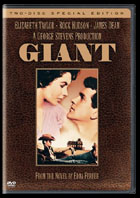 Giant, James Dean’s last film before his fateful meeting with a station wagon, was Warner Bros. highest grossing film and claimed that title for 22 years before the release of Superman in 1978 when Christopher Reeve and crew snatched the title away from Giant’s cold Texan hands. There is a magnitude of good reasons why Giant claimed that title for so many years and I will describe those reasons using a number of single words.
Giant, James Dean’s last film before his fateful meeting with a station wagon, was Warner Bros. highest grossing film and claimed that title for 22 years before the release of Superman in 1978 when Christopher Reeve and crew snatched the title away from Giant’s cold Texan hands. There is a magnitude of good reasons why Giant claimed that title for so many years and I will describe those reasons using a number of single words.
Strong… performances, that is. A young Rock Hudson and Elizabeth Taylor play a believable young couple that falls in love when Hudson comes shopping for a prize horse and leaves with Taylor on his arm. The two continue their lives on Bick Benedict’s (Hudson) half million acre ranch and their story spans across two (or three if you want to be technical) generations. Rock Hudson maintains a strong presence that slowly degenerates as his character grows older. This breaking down is important not only to Hudson’s character, but also to the story itself. Elizabeth Taylor plays the young Leslie Lynnton with such poise that it’s hard not to compare her to Scarlett O’Hara from Gone With the Wind. This comparison is quickly thrown out of the window once Leslie displays her ability to control her emotions and to immerse herself in her new Texan surroundings.
James Dean portrays a Benedict ranch hand named Jett Rink. Rink has a number of scenes early on in the film, but he doesn’t come into play until later in the game, particularly at the two hour mark. This is when Rink hits oil on his small section of land bequeathed from Bick Benedict’s late sister. Rink then becomes a major player in the last hour and a half of the film as we follow his wealth in a number of set montages. Dean plays the character of Rink very well, but I can’t help but to want more intimate moments with his character, especially if his character is what pushes the last half of the story. The lack of focus throws the film into a tailspin, one that I feel it doesn’t quite level itself out of. Granted, there are plenty of great character moments in the closing moments of the film, but it’s not quite as satisfying as it needs to be.
Epic… Giant is unnecessarily epic, in my opinion. The second portion of the film pushes the film towards an unnecessary “epic” level even though it does take the time to address racial issues which are pushed early into the story. It feels as if the first two hours are a completely different movie in terms of tone and story when compared to the last hour and a half. Where a film like Gone With the Wind showcased its characters over a number of decades, it may have been a better idea to make the second portion of Giant another film, released shortly after or after a period of time in order to let the first part of the film breathe by itself. (I know I keep comparing this to Gone With the Wind, but I can’t help not to in some cases.) The second portion of Giant would be a sequel of sorts, if you think about it.
Aggressive… or adessive, which means “speaking, while speaking.” Giant is adessive particularly in terms of race issues, especially in the beginning of the film where we see Leslie tackling the racial discrimination against the Mexican “wetbacks” head on. Leslie sees the Mexican people as human beings on an equal level with her in terms of humanity and sets out to help them. There remains an obvious class difference between Leslie and these people, but we see her doing her best to ensure that the life of these people is better off. Bick is displeased with Leslie’s actions at first, but eventually he lets her have her way and simply doesn’t pay much attention to what she is doing to help. It isn’t until the second part of the film that Bick becomes involved after his son Jordan (Dennis Hopper) marries a Mexican woman and faces social issues at every turn. Giant speaks mountains in the last minutes of the film and it leaves us with the hope that the world will be a better and more understanding place for Bick’s grandchildren and for our own grandchildren, a message that still shines through even after the number of decades that have passed since the film’s release.
Giant is indeed an epic film that delivers on so many levels but eventually comes crumbling down on itself in the second half. It is a glowing tribute of James Dean’s acting career and I only wish that we would have been able to spend more time with his character when it was really needed.
6.5 out of 10
The second disc takes a queue from the film’s title and is all about the special features. To begin with, there are two very similar toned documentaries. The first is titled, Memories of Giant which features interviews with a number of the film’s cast and crew. This documentary does seem to become a little repetitive, as if the editors were forced to stretch things out to an hour running time. The second documentary, Return to Giant, features interviews and footage from the small town of Marfa, Texas. In my opinion, this is the better of the two documentaries, as it displays the relationships between the cast, crew, and local townspeople during the shooting of the film. As the documentary plays out, you feel as if these people were at a movie summer camp, something I became oddly jealous of wanting myself.
Also included is a New York Premiere TV Special Hollywood Premiere Featurette which is essentially a live broadcast such as you would see today before the Emmys and Oscar ceremonies. There’s a lot of ego stroking throughout the featurette which becomes annoying very quickly. It was interesting to see how Jack Warner interacted live on camera; he had a number of canned jokes that he slipped in quite well in his short appearance. There’s a ton of awkward moments, moments that you can’t help but to have when you are broadcasting live on the air. The quality of the broadcast is poor, but that’s the best they could do back in the day.
Next is a Project Kickoff Newsreel which shows the cast and crew heading for Marfa, Texas in order to shoot the film. Also included are two Behind the Cameras segments which discuss a number of things I already learned from watching the two documentaries beforehand.
Three (or is it four?) theatrical trailers are also included. The original teaser trailer is a book style, much like the teaser trailer for Gone With the Wind. The trailers that allow are essentially the same; the title cards are the only things that drastically change from one re-release trailer after another.
There are also a number of production notes which really help give you insight on the pressure that was put on director George Stevens each day as he attempted to put the story of Giant on film. Many of the notes are from Jack Warner himself which mostly consist of him harking on the budget (James Dean made very little for his performance) and running time of the film. I really enjoyed reading these, even though I had to use the zoom feature on my DVD player in order to read most of them.
Finally, is a set of production stills which show much of the behind the scenes elements of the filming of Giant. Overall, a quite impressive and informative set of special features alongside this film.
9.0 out of 10
The Artwork
I’m not too terribly impressed with the artwork, but it works here. The leather pattern screams fake to me as I was expecting something a little more in terms of poster art, even though the middle picture is from one a poster composition.
8.0 out of 10

The James Dean Collection
Overall: 8.0 out of 10
The Look
When I reviewed Gone With the Wind some months ago, I assumed that I would never see a better looking restoration of a classic film; boy was I wrong. This restored transfer for Giant is immaculate. From the opening sequence I sat in awe. Believe me, when you see that black locomotive against the green hills of Virginia, you will know that you’re in for a good visual ride. Everything is sharp, crisp, and colorful. To be honest, the transfer is simply breathtaking at times.
10 out of 10
The Noise
In terms of sound this mix sounds pretty damn good. Giant gets the complete Dolby 5.1 remix and there are moments where this really shines through, especially in terms of sound effects. The score does ring a little to monotone, but I wasn’t expecting anything this fine.
9.0 out of 10

This is what I like to call "Pulling a Bob Dole".
The Goodies
These discs are packed I tell you. Included along with the film on the first disc is a commentary with film critic Stephen Farber, screenwriter Ivan Moffat and George Stevens, Jr. The trio does a good job discussing the film, especially Jr., whom worked on the film alongside his father. There’s also a documentary entitled, George Stevens: Filmmakers Who Knew Him which includes the likes of Warren Beatty and Frank Capra (among others). There are number of great stories throughout the hour documentary, including many stories regarding the filming of Giant itself.

Badass.
When it comes down to it, the first two hours of Giant sweeps up the imagination and sets you smack down in the heart of Texas. The rock solid performances of Hudson, Taylor, and Dean aren’t to blame here. It’s the last hour and a half of watching Bick and Leslie dealing with their older children and also watching a crumbling under characterized Jett Rink that set the film askew. You grow to only care about one of the Benedict children, Jordan, as he deals with the struggles of marrying a Mexican woman. But that just isn’t enough as the two portions of the film feel worlds apart from one another without a solid transition to connect the two. A simple fade out and fade in just isn’t going to cut it here.
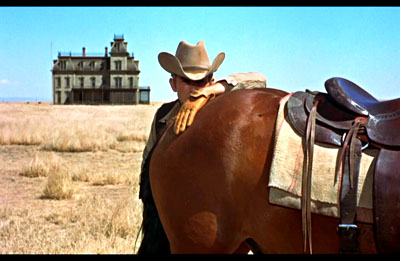
No matter the species, James Dean was definitely an ass man.
Long… When it comes down to it, I could have lived with the first portion of the film without needing the last hour and a half portion. The portion I speak negatively of is on the second side of the first disc. I personally didn’t feel the length of the film until I had to flip the disc over. After that point, everything just seems to trudge along until the closing moments. The two portions of the film feel very disjointed, and I don’t believe that it’s due to having the film on separate sides of a disc. It has to do with a number of issues that I will address below.
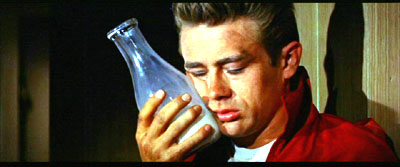
"Oh milk… I’ll never ever stop loving you."
The Look
From the start you can tell that some work was done on the original print for this release. Everything looks much cleaner and sharper which really helps make the picture not look as old as it really is. There are some contrast issues I wish they would have picked up on, but I wasn’t even expecting this level of quality so I can’t complain too much.
8.5 out of 10
The Noise
The sound is a different issue compared to the work put into the quality of the transfer. The score could have used some work, as it sounds very stiff and monophonic. It’s not your high-caliber full Dolby mix, but it’s nothing to go running home crying to your momma about either.
7.0 out of 10
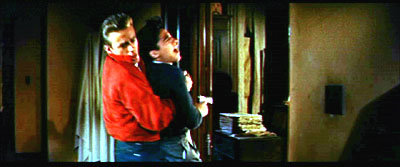
Dean was disappointed when he learned that his agent signed him up to star in the new hour long, Heimlich Removers Gone Bad 3.
The Goodies
The included commentary by Douglas L. Rathgeb is pretty solid. With older films, it’s hard to find anyone associated with the film to do any commentary, so studios usually settle the problem by grabbing a film historian. That solution usually goes two ways; good or bad. In this case, Douglas is the author of The Making of Rebel Without a Cause and he seems pretty knowledgeable on the subject at hand. He tells quite a few interesting behind the scenes stories that I’d never heard before which really helps present the emotion behind the performances.

One of the Nation’s Bitchslapped. Which is pretty close to Punched in this case, considering the size of that man hand.
Plato, on the other hand, looks to Jim as a father figure and it’s apparent that Jim isn’t prepared for that role; he’s got enough problems of his own. Plato’s obsession with Jim is later revealed to have a connection to Plato’s parents. After this discovery, Jim’s life doesn’t seem that bad when compared to Plato’s. Plato’s inconsistent lying and fibbing to the people around him doesn’t seem to have any consequences as nobody seems to believe what he’s saying anyways. He’s a pathetic character that just happens to meet Jim at the right place at the right time. Judy’s connection to Jim after the incident at the “chickey run” sets up another person that Plato embraces as his own; most likely in placement of his mother. With this dynamic, I find Plato to be the most interesting and layered character in the film even though we are to led to look more towards Jim and his progression throughout the film.
After the incident and argument at Jim’s home, the three main characters flee to an abandoned mansion near the observatory where the trio visited earlier that day. Jim and Judy flee there first and Plato later joins them to warn Jim that Buzz’s gang is out looking for him to seek revenge. Plato is packing heat unbeknownst to anyone other than Plato’s nurse, whom tried to stop him from fleeing his house with the weapon. At the mansion, fun is had until Buzz’s gang show up with the police shortly arriving to investigate the disturbance.
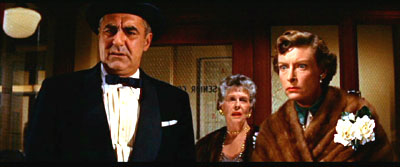
Mr. Howell was appalled upon seeing what really goes on inside the Skipper and Gilligan’s hut every night.
With so much already against him, Jim’s also the new kid in town. This feeling for Jim isn’t anything new, as we learn that his family moves him around quite a bit. We don’t ever quite know for sure what caused Jim’s family to move to their current location but we can guess that at the sign of trouble, Jim’s family packs up and flees to a new location. Also against Jim is a local “group” of kids that set their eyes on him. This group quickly embarks to “make friends” with him during a field trip to a local observatory. (Note: Judy is a part of this “group”.) Their leader, a confident young man named Buzz (Corey Allen) slashes one of the tires on Jim’s car with the hopes of catching Jim in a heated moment. Jim goes through a wave of emotions in this scene, which ends with him overpowering Buzz during a knife fight; a scene that sets the stage for a deadly “chickey run” later that night.
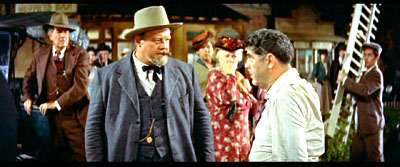
I don’t have a caption for this image, but I love how the guy in the background is about to use a section of a fence as a weapon.
The Look
The film, especially in darker lit scenes, seems a bit washed out to me. I found there to be a noticeable lack of contrast particularly with darker colors. The film doesn’t have quite the vibrant spectrum as say Gone With the Wind, but a little bit more work could have gone into making this release a little easier on the eyes.
7.0 out of 10
The Noise
The sound, on the other hand, is a completely different matter. This is a complete Dolby 5.1 remix which sort of baffles my mind a bit. To me the film doesn’t need the treatment, considering a film like Rebel Without a Cause still lives within its basic stereo mix. Nonetheless, the new soundtrack enhances the film experience and makes things easier to hear, especially in the film’s quieter moments.
8.0 out of 10

They were cornered. There was no escaping the shadow of Giant Head.
The Goodies
Where to start? These sets are packed full of special features, this one in particular.
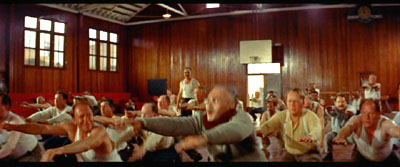
When the Metamucil didn’t work the boys had to turn to group squatting therapy.
East of Eden is a much quieter film, one with a little more intimacy with the main character than I expected there to be. In one way this intimacy is a good thing and in another way it hurts the film as we are forced to see the events unfold from the very confused perspective of the main character. Abra is probably the saving grace of this nuance, considering she feels for both Cal and for his brother. She’s a neutral party that can see things in terms of the bigger picture and her perspective gives Cal the tools he needs to get closer to his father. Harris’ performance is of a sweet nature, just the right touch in order for us to make her storyline believable.
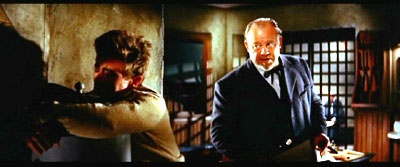
"Boy, humans and water coolers don’t intermingle. At least not in these parts. Give Canada a shot."
Speaking of the war… World War I plays a significant role in the story due to Aron’s disapproving of it in addition to his father’s position on the local war board. Both Aron and his father have unfavorable viewpoints on the war, and when Cal gives the money to his father as a birthday present, he is presented with a furious and negative response from his father, but not before being outdone by his brother announcing his recent engagement to Abra. This spins Cal out of control and he sets out to get back at both his brother and his father.
